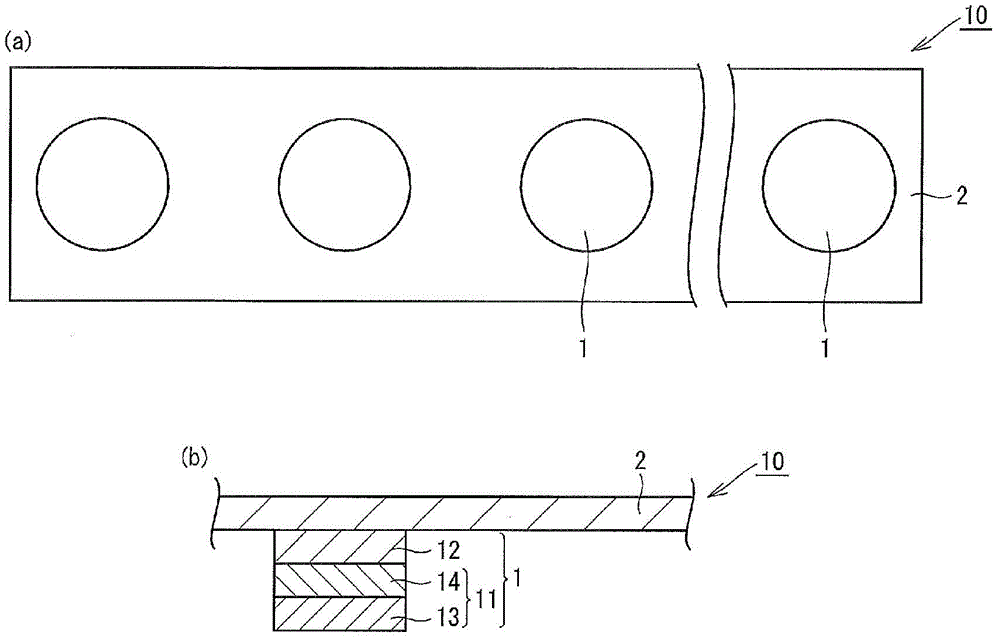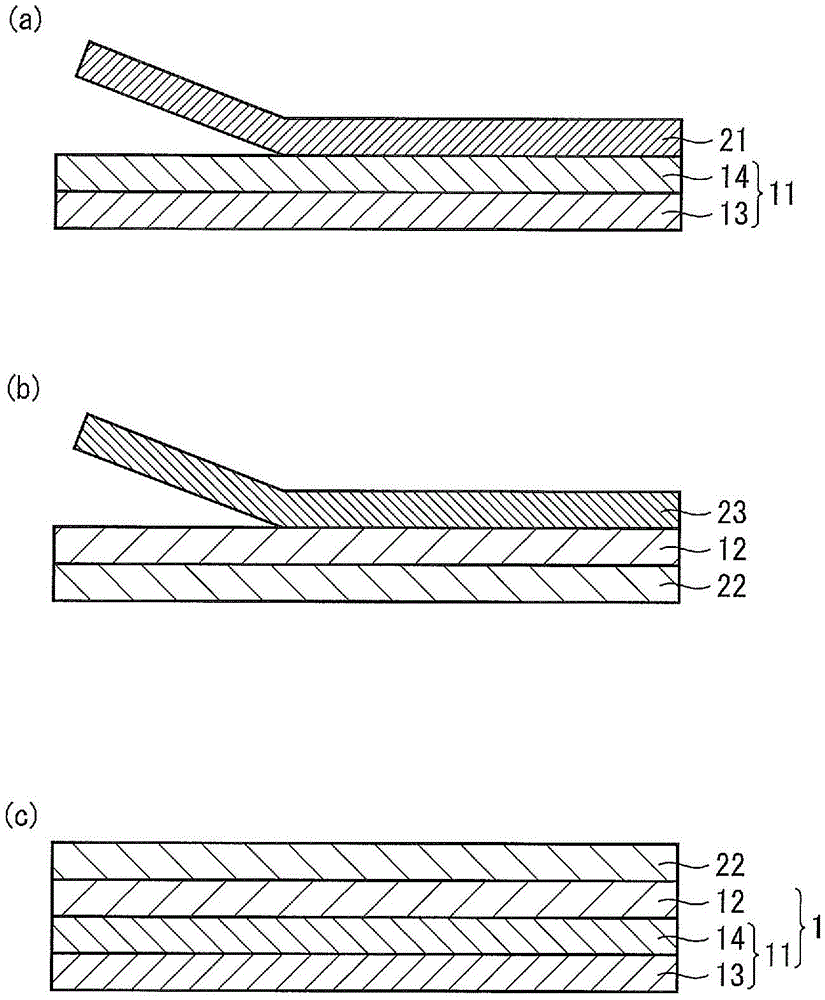Thin film for semiconductor device and semiconductor device
A semiconductor and thin-film technology, which is applied in the direction of semiconductor devices, semiconductor/solid-state device manufacturing, semiconductor/solid-state device components, etc., can solve the problems of semiconductor wafer retention and peelability decline
- Summary
- Abstract
- Description
- Claims
- Application Information
AI Technical Summary
Problems solved by technology
Method used
Image
Examples
Embodiment 1)
[0131] (Preparation of adhesive layer for dicing film)
[0132] Add 76 parts of 2-ethylhexyl acrylate (2EHA), 24 parts of 2-hydroxyethyl acrylate (HEA) and 0.2 parts of benzene peroxide into a reaction vessel with a condenser tube, nitrogen introduction tube, thermometer and stirring device Formyl and 60 parts of toluene were polymerized at 61° C. for 6 hours in a nitrogen stream to obtain an acrylic polymer A with a weight average molecular weight of 750,000. The molar ratio of 2EHA to HEA is 100 moles to 20 moles. The measurement of the weight average molecular weight is as described above.
[0133] 10 parts (80 mol % with respect to HEA) of 2-methacryloyloxyethyl isocyanate (hereinafter referred to as "MOI") was added to this acrylic polymer A, and the addition was carried out at 50°C for 48 hours in an air stream. Reaction treatment to obtain acrylic polymer A'.
[0134]Then, to 100 parts of acrylic polymer A', add 6 parts of isocyanate crosslinking agent (trade name "C...
Embodiment 2)
[0150]
[0151] As the dicing film of this example, the same dicing film as in Example 1 was used except that a 100 μm polyolefin film (substrate) was attached to the adhesive layer.
[0152]
[0153] With respect to 100 parts of an acrylate-based polymer mainly composed of ethyl acrylate-methyl methacrylate (manufactured by Negami Industry Co., Ltd., trade name: パラクロン W-197CM, Tg: 18°C, weight average molecular weight: 400,000), 434 parts of epoxy resin (manufactured by Nippon Kayaku Co., Ltd., trade name: EOCN-1027), 466 parts of phenolic resin (manufactured by Mitsui Chemicals Co., Ltd., Milex XLC-4L), and 1500 parts of spherical silica as an inorganic filler (manufactured by Admatechs Co., Ltd., trade name: SO-25R, average particle diameter: 0.5 μm) and 3 parts of curing catalyst (manufactured by Shikoku Kasei Co., Ltd., C11-Z) were dissolved in methyl ethyl ketone and adjusted to a concentration of 20% by weight. In addition, the tensile storage modulus of the adhesiv...
Embodiment 3)
[0160]
[0161] In the dicing film of this example, in addition to using an adhesive tape base material (thickness 100 μm) containing only random polypropylene resin (MFR: 2 g / 10 minutes, ethylene content: 60 wt %) as the adhesive layer, using The same cutting film as in Example 1. In addition, corona treatment was given to one surface of the adhesive tape base material. Then, a polyolefin film (substrate) having a thickness of 100 μm was pasted on the surface of the pressure-sensitive adhesive layer. Then, it was kept at 50° C. for 24 hours.
[0162]
[0163] For 100 parts of acrylic rubber (manufactured by Nagase Sangyo Co., Ltd., trade name: SG-708-6), 434 parts of epoxy resin (manufactured by Nippon Kayaku Co., Ltd., trade name: EOCN-1027), 466 parts of phenolic Resin (Milex XLC-4L manufactured by Mitsui Chemicals Co., Ltd.), 429 parts of spherical silica (manufactured by Admatechs Co., Ltd., trade name: SO-25R, average particle size: 0.5 μm) as an inorganic filler w...
PUM
| Property | Measurement | Unit |
|---|---|---|
| glass transition temperature | aaaaa | aaaaa |
| storage modulus | aaaaa | aaaaa |
| thickness | aaaaa | aaaaa |
Abstract
Description
Claims
Application Information
 Login to View More
Login to View More - R&D
- Intellectual Property
- Life Sciences
- Materials
- Tech Scout
- Unparalleled Data Quality
- Higher Quality Content
- 60% Fewer Hallucinations
Browse by: Latest US Patents, China's latest patents, Technical Efficacy Thesaurus, Application Domain, Technology Topic, Popular Technical Reports.
© 2025 PatSnap. All rights reserved.Legal|Privacy policy|Modern Slavery Act Transparency Statement|Sitemap|About US| Contact US: help@patsnap.com



